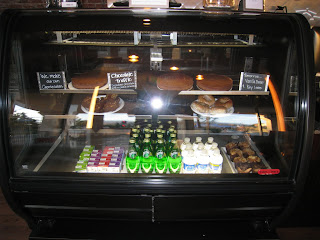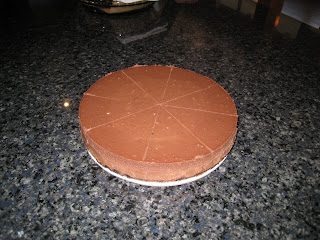It is Wednesday evening. I wanted to head into The Haven Cafe to start stocking up the dessert case for the weekend. When I arrived I found that only two or three pieces of my original 2 cheesecakes were left! It was a good thing that I came to make cheesecake otherwise they wouldn't have much for Thursday!
Once we get into the swing of things, we plan on having 3 cheesecake flavors at all times. One of those will always be the vanilla bean, and the other two will be whatever I feel like making for that week. Hopefully I can settle into a groove, bust out all my cheesecakes over the weekend and then not have to come in during the week. We'll see how that goes, but in the meantime, as I figure out all of the intricacies of this kitchen, it looks like I'm coming in whenever I get time to bake, and/or if they are running low on stock.
 |
| The Display is full-o-chocolate truffle! |
One of the issues I have in this experience is adapting my recipes to the smaller pans that I am using, but also adjusting for quantity as well. I typically make a single nine inch cheesecake, and now I am making four eight inch cheesecakes! The engineer in me wants to apply a simple ratio to determine exact amounts of each ingredient... but it isn't quite that simple. 4 x (8/9) x the quantity of ingredient. This would be the formula I would use if I were taking that route. Four is the total number of cheesecakes, and 8/9 is the ratio of pan sizes. This formula tells me that when I typically use 24 oz. of cream cheese, I now need to use 85.3 oz. of cream cheese. But it also tells me that when I use 3 eggs, I now have to use 10.67 eggs. I personally don't want to mess with fractions of eggs and for that reason this method is out. I had to keep it simple,and since eggs are the one thing I can't easily divide into fractions, that would be my defining quantity for the ratio needed.. Since I typically used three eggs for one cheesecake, and I had to decrease the volume, I would now use two eggs for one, meaning eight eggs for all four cheesecakes in each batch. The new formula is 4 x (2/3) x the quanitity of ingredient. This gives me the amount of cream cheese to use, as well as all of the other ingredients which are easily scalable.
With the batter mixed and poured, I slid all of the cheesecakes into the oven. Four cheesecakes crammed into this small oven was tight. I was going to have to rotate these part way through baking. Ovens are hotter at their walls than in the cavity, particularly if you are opening and closing the door. If you can't place your baked good in the center of the cavity, but don't rotate it part way through the baking process, then the parts closest to the walls of the oven will cook faster. To avoid this you have to rotate the items part way through the baking time. Baking time is another thing that has to scale based on variables when baking a cheesecake. I bakes a typical nine inch at 300 degrees for about an hour. I was baking four eight inch cheesecakes at 250 degrees, so I figured that it would be roughly the same time frame, but I like to be cautious so I set a timer for 20 minutes to rotate them. At that time they seemed like they were setting well. After rotating I left them in for another 15 minutes and they were set very well, probably a little overdone actually.
As I was rotating I noticed that two of the cheesecakes had water on top of them. To get everything to fit I had to put the water bath on the top rack above the cheesecakes. In addition to that the oven itself isn't level. So the two cheesecakes on the downhill side got some liquid on top of them when the oven shook... which was every time that the oven door opened. Fortunately when set, cheesecake can handle some water and it evaporated before causing any problems.
 |
| Chocolate Truffle Cheesecake |
I learned a lot of lessons during this baking session. First, level the oven. Second, it will take some time, but eventually I will figure out an optimum timing and temperature for baking in this environment. Third, I have to get an early start. This leads me to my tip for this article:
Though the mixing and baking of a cheesecake and crust takes a fair amount of time, probably 1.5-2 hours, it is nothing compared to the time that it has to sit and cool prior to being able to do anything with it. If you remove a cheesecake from a hot oven to cool, the drastic temperature fluctuation will cause it to crack and dry out. For this reason it is best to slightly undercook it, then turn the oven off, crack the door, and let the cavity of the oven come down to room temperature. Then remove the cheesecake and allow it to cool completely before covering and placing in a fridge to chill. This will take another 3-4 hours depending on the size of cheesecake. I would apply this technique with any custard. I took a couple of liberties with time on Wednesday night, particularly that the cheesecakes were still not completely room temperature when I covered them and put them in the fridge. Even with those liberties, I didn't get home until nearly 1 AM. To prep the cheesecakes for the display case I had to go back Thursday morning before I went to work. In all I was "baking" for approximately 6 hours. I know that as I become more adept and get systems down for everything that this I can reduce this time substantially.